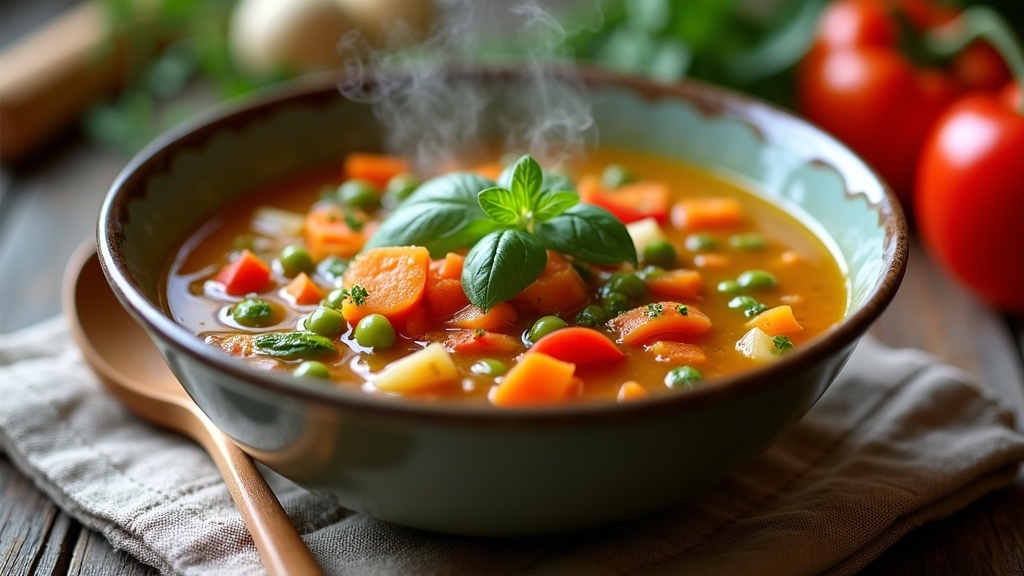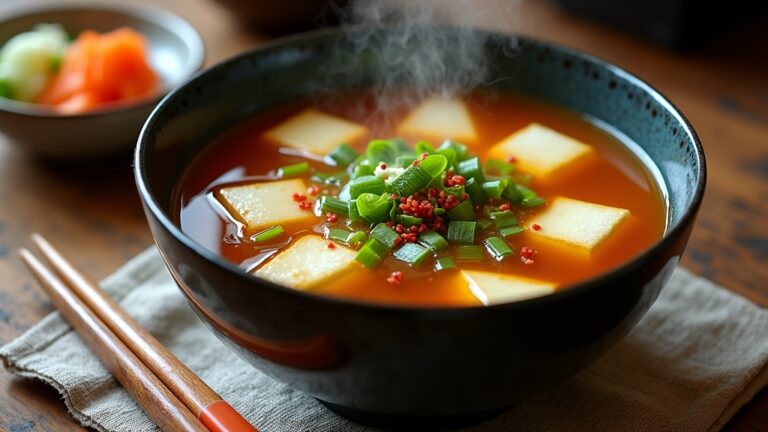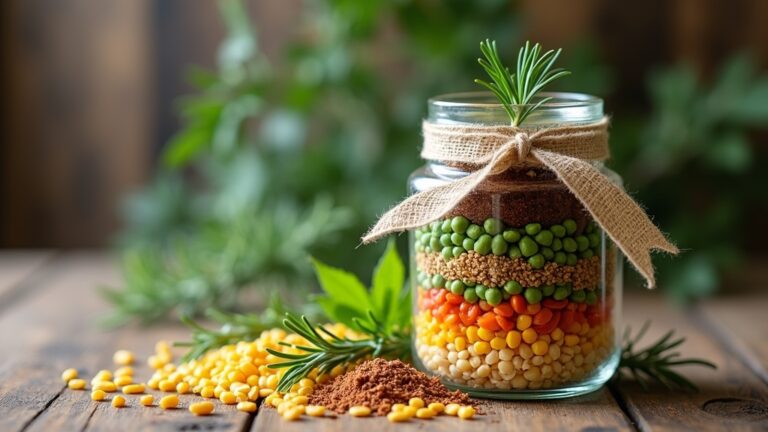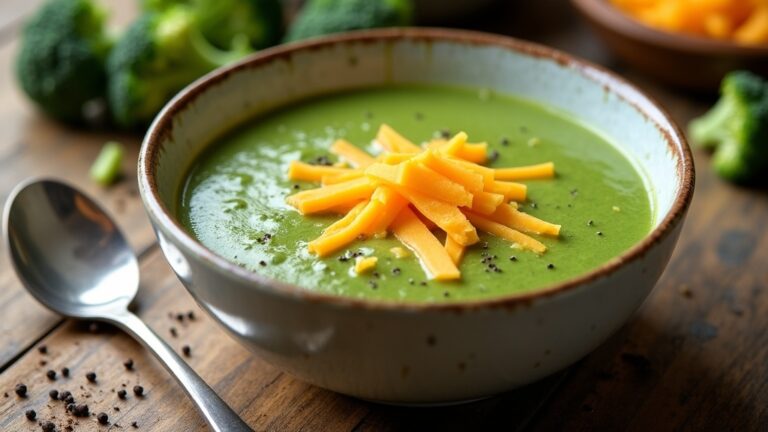Vegetable Soup Recipe
I love whipping up a hearty vegetable soup, perfect for chilly days! I sauté diced onions, carrots, and celery in olive oil, then pour in vegetable broth and let it simmer until they’re tender. Adding fresh herbs and spices really elevates the flavor. It’s an easy, customizable dish that’s nourishing and comforting. On top of that, it’s packed with vitamins from whatever veggies you choose to include. Stick around, and I’ll share more about its benefits and history!
Contents
History
When I think about the history of vegetable soup, I can’t help but appreciate its evolution through time and cultures. Its roots stretch back to ancient civilizations, where it served as a hearty meal for communities, nourishing both body and spirit. In places like Mesopotamia and Egypt, cooks would combine seasonal vegetables in clay pots, creating not just sustenance but a canvas for cultural expression. This dish holds tremendous cultural significance, adapting to regional ingredients and culinary practices. As I explore its rich tapestry, I find innovative twists emerging, proving that vegetable soup is not just a relic of the past but a dynamic dish that continues to inspire creativity in kitchens around the world.
Recipe
Making a hearty vegetable soup is a delightful way to warm up on a chilly day while also packing in a variety of nutritious vegetables. This recipe is versatile and can be adjusted based on the vegetables you have on hand, making it an excellent choice for clearing out your fridge. The combination of fresh herbs and spices will elevate the flavors, creating a rich and comforting dish that the whole family can enjoy.
A hearty vegetable soup warms the soul, utilizing nutritious ingredients and fresh herbs for a comforting family dish.
This vegetable soup is not only easy to prepare but also customizable to suit your taste preferences. You can add beans for extra protein, toss in some leafy greens for added nutrition, or vary the spices to create different flavor profiles. Serve it with crusty bread for a complete meal, or enjoy it on its own as a nourishing snack.
Ingredients:
- 2 tablespoons olive oil
- 1 onion, diced
- 2 carrots, sliced
- 2 celery stalks, diced
- 3 cloves garlic, minced
- 6 cups vegetable broth
- 1 can (14.5 oz) diced tomatoes
- 2 cups potatoes, diced
- 1 cup green beans, chopped
- 1 cup corn (fresh, frozen, or canned)
- 1 teaspoon dried thyme
- 1 teaspoon dried basil
- Salt and pepper to taste
- Fresh parsley for garnish (optional)
In a large pot, heat the olive oil over medium heat. Add the diced onion, carrots, and celery, and sauté until the vegetables begin to soften, about 5-7 minutes. Stir in the garlic and cook for another minute until fragrant. Pour in the vegetable broth and add the diced tomatoes, potatoes, green beans, corn, thyme, and basil. Bring the mixture to a boil, then reduce the heat and let it simmer for about 30 minutes, or until the vegetables are tender. Season with salt and pepper to taste.
When cooking vegetable soup, feel free to experiment with different vegetables or herbs based on what you enjoy or have available. For a creamier texture, consider blending a portion of the soup after cooking. To enhance the flavor, try adding a splash of balsamic vinegar or a squeeze of lemon juice just before serving. Finally, vegetable soup can be stored in the refrigerator for up to 5 days or frozen for longer storage, making it perfect for meal prep!
Cooking Steps
Let’s get started on making that delicious vegetable soup! First, I chop up fresh vegetables finely and sauté them in olive oil to bring out their flavors. Once they’re tender, I add vegetable broth and let everything simmer, filling the kitchen with an enticing aroma.
Step 1. Chop Fresh Vegetables Finely
Chopping fresh vegetables finely is essential for creating a flavorful vegetable soup that melds all the ingredients beautifully. When I prepare my soup, I like to start with vibrant carrots, celery, and bell peppers, ensuring each piece is no larger than a quarter-inch. This not only enhances the texture but also allows the vegetables to cook evenly, releasing their natural flavors. I find that finely chopped garlic and onions add depth, while fresh herbs like thyme or basil elevate the aroma. Using a sharp knife makes the process smoother and safer, allowing me to enjoy the rhythm of chopping. The more care I take in this step, the more delightful my soup becomes, inviting everyone to savor every spoonful.
Step 2. Sauté in Olive Oil
Once the vegetables are finely chopped, I heat a generous splash of olive oil in a large pot over medium heat. The aroma of the oil warming up fills my kitchen, promising a flavorful base for the soup. I use sauté techniques to gently cook the vegetables, stirring occasionally to guarantee even tenderness. The olive oil not only enhances the flavors but also brings its numerous health benefits, such as heart-healthy fats and antioxidants. As the vegetables soften and begin to caramelize, I can’t help but feel excited about the vibrant colors and rich flavors developing. This step is essential; it lays the groundwork for a hearty, innovative vegetable soup that’s both nutritious and delicious.
Step 3. Add Vegetable Broth
Adding the vegetable broth is an essential step that transforms the sautéed vegetables into a comforting soup. I love to choose a high-quality vegetable broth, which enhances the flavors and brings out the natural sweetness of the veggies. There are various broth types available, from rich, homemade options to organic store-bought varieties, each offering unique taste profiles. As I pour in the broth, I can almost feel the nutrients—packed with vegetable benefits—infusing into the mixture. This broth not only adds depth but also serves as a canvas for creative seasoning, enabling me to personalize my soup. Each spoonful will be a delightful blend of flavors, providing warmth and nourishment, perfect for any occasion.
Step 4. Simmer Until Vegetables Tender
As the broth begins to bubble gently, I lower the heat and let the mixture simmer, allowing the flavors to meld beautifully. This is the moment to embrace some creative simmering techniques. I watch as the vibrant vegetables soften, their textures evolving from crisp to tender, creating a harmonious blend in the pot. Carrots release their sweetness, while potatoes become creamy, infusing the broth with nourishing goodness. I often stir gently, encouraging even cooking and preventing any sticking. The key is patience; a low simmer for about 20-30 minutes works wonders. Each vegetable contributes its unique essence, enhancing the soup’s overall character. By the end, I’m rewarded with a comforting, wholesome dish that’s both inviting and innovative.
Step 5. Season With Herbs and Spices
With the vegetables tender and their flavors beautifully melded, it’s time to elevate the soup by seasoning it with herbs and spices. I love experimenting with various herb combinations to find the perfect balance. Fresh basil and thyme can bring a fragrant twist, while rosemary adds a hearty depth. For a spicy kick, I often play with spice ratios, adding just a pinch of cumin or smoked paprika to enhance the soup’s warmth. As I sprinkle in my chosen herbs and spices, I taste frequently, adjusting until it sings. Remember, seasoning is an art—don’t be afraid to innovate. Allow your palate to guide you, and you’ll create a vegetable soup that’s both comforting and bursting with flavor!
Nutritional Guide
When I whip up a pot of vegetable soup, I’m not just treating my taste buds; I’m also nourishing my body with a blend of vitamins and minerals. Each ingredient brings its own nutritional benefits, creating a powerhouse of health in every bowl. For those with dietary considerations, this soup is incredibly versatile—whether you’re vegan, gluten-free, or simply looking to boost your nutrient intake.
Here’s a quick look at the nutritional highlights:
| Vegetable | Key Nutrients |
|---|---|
| Carrots | Vitamin A, Fiber |
| Spinach | Iron, Vitamin K |
| Tomatoes | Vitamin C, Antioxidants |
| Bell Peppers | Vitamin C, Fiber |
| Zucchini | Vitamin B6, Manganese |
With each sip, I know I’m fueling my body right!
Final Thoughts
While I savor the last spoonful of my homemade vegetable soup, I can’t help but reflect on the joy it brings, not just in flavor but in nourishment. This dish is a canvas for creativity—experimenting with various soup variations keeps it exciting and fresh. Whether I swap out kale for spinach or add a splash of coconut milk for creaminess, ingredient substitutions open up a world of possibilities. I love how each batch can tell a different story, highlighting seasonal produce or pantry staples. This soup is more than just a meal; it’s an invitation to innovate. So, I encourage you to embrace your culinary instincts and make this recipe your own—your taste buds will thank you!
Frequently Asked Questions
Can I Freeze Vegetable Soup for Later Use?
Absolutely, I’ve frozen vegetable soup using smart freezing techniques. I store it in airtight containers, ensuring freshness. It’s a game-changer for meal prep, letting me enjoy homemade goodness anytime I crave it. Give it a try!
What Vegetables Are Best for Soup?
Sensational soups start with seasonal vegetables like vibrant carrots and crisp celery. I love adding hearty root vegetables, too, such as potatoes and parsnips, creating a comforting, flavorful blend that warms the soul. You’ll adore it!
How Long Does Vegetable Soup Last in the Fridge?
I’ve found that vegetable soup lasts about three to five days in the fridge. For ideal shelf life, I recommend storing it in airtight containers and cooling it quickly to retain its delicious flavors.
Can I Make Vegetable Soup in a Slow Cooker?
Absolutely, I love making vegetable soup in my slow cooker! The benefits are amazing; it enhances flavors while I relax. Cooking times typically range from four to eight hours, ensuring a delicious, hearty meal awaits me.
What Can I Add for Extra Flavor in Vegetable Soup?
To boost flavor, I love adding fresh herbs like basil and thyme, along with spices such as cumin or smoked paprika. Experimenting with different broth options also elevates the taste to a whole new level!
Conclusion
As I ladle the vibrant vegetable soup into a bowl, I can almost see the sun setting over a harvest field, each ingredient a burst of color and flavor. This comforting dish warms not just the body but the soul, inviting you to savor each spoonful as if it were a cherished memory. So, gather your fresh veggies, let their stories intertwine, and create a symphony of taste that dances on your palate—it’s a nourishing hug in a bowl.










